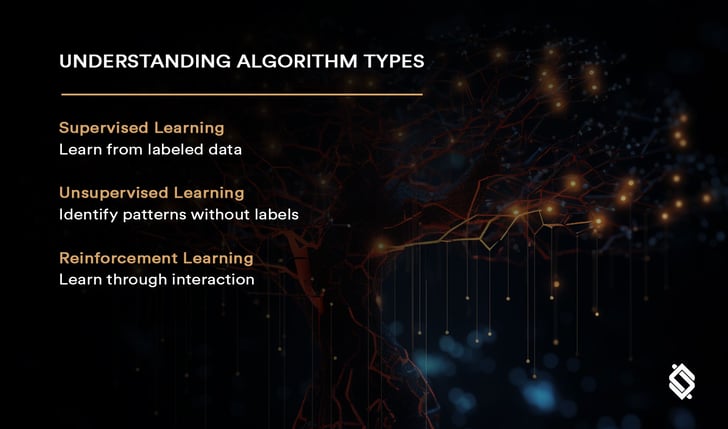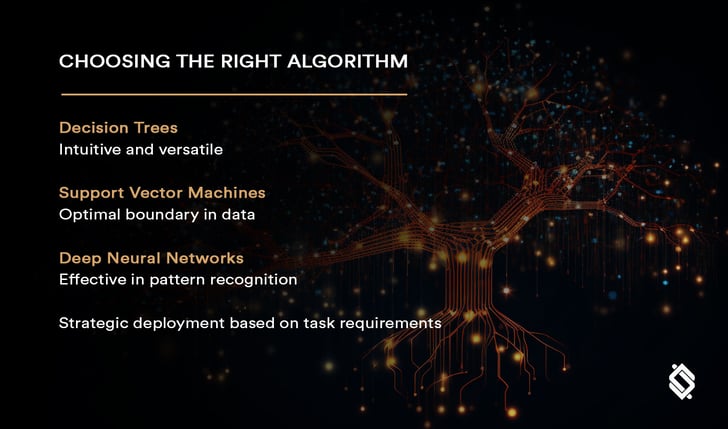In the ever-evolving landscape of technology, the integration of machine learning (ML) has become the linchpin for innovation. For leaders in technology companies, navigating the complex terrain of ML model selection is paramount to unlock the full potential of artificial intelligence (AI) projects. In this extensive exploration, we will embark on a journey that spans understanding the types of algorithms, choosing the right algorithm, delving into hyperparameter tuning and cross-validation, evaluating model performance, envisioning future developments, and finally, a concluding reflection on empowering leaders in the era of machine learning.
Understanding the Types of Algorithms: A Prerequisite for Innovation

To embark on the machine learning journey, one must first comprehend the fundamental types of algorithms that form the backbone of AI systems. These algorithms can be broadly categorized into three main types: supervised learning, unsupervised learning, and reinforcement learning.
Supervised Learning: Guided by Labeled Data
In supervised learning, algorithms are trained on a labeled dataset, where the input data is paired with corresponding output labels. The algorithm learns to map the input data to the correct output during the training phase. This type of learning is particularly effective for tasks such as classification and regression.
Unsupervised Learning: Unearthing Hidden Patterns
Contrastingly, unsupervised learning operates on unlabeled data, seeking to identify patterns or structures within the dataset without predefined output labels. Common applications include clustering and dimensionality reduction, enabling the algorithm to reveal inherent relationships among data points.
Reinforcement Learning: Learning from Interaction
Reinforcement learning involves an agent interacting with an environment and learning to make decisions by receiving feedback in the form of rewards or penalties. This type of learning is prevalent in scenarios where an algorithm must make a sequence of decisions, such as in gaming or autonomous systems.
Choosing the Right Algorithm: Navigating the Algorithmic Landscape

With a foundational understanding of algorithm types, the next crucial step is choosing the right algorithm for a specific task. Each algorithm comes with its unique strengths and limitations, making informed decision-making imperative.
Decision Trees: Intuitive Decision-Making
Decision trees are intuitive and easy to interpret, making them ideal for scenarios where transparency in decision-making is essential. Their ability to handle both numerical and categorical data, along with their resistance to irrelevant features, positions them as versatile tools.
However, decision trees may struggle with complex relationships within data, potentially leading to overfitting. Strategic deployment of decision trees involves understanding these trade-offs and leveraging their interpretability where it matters most.
Support Vector Machines: Crafting Optimal Boundaries
Support Vector Machines (SVMs) excel in scenarios where the data is not linearly separable. By transforming input features into higher-dimensional spaces, SVMs can find optimal boundaries between different classes. Their effectiveness in classification tasks has made them popular in various domains.
Despite their prowess, SVMs can be computationally intensive, especially with large datasets. As technology advances, these computational challenges are gradually diminishing, making SVMs increasingly viable for a broader spectrum of applications.
Deep Neural Networks: Unleashing Complexity for Innovation
Deep Neural Networks (DNNs) have emerged as the driving force behind many AI breakthroughs. Mimicking the human brain's structure, DNNs excel at handling vast amounts of data and extracting intricate patterns, making them particularly effective in tasks such as image and speech recognition.
Yet, the complexity of DNNs demands significant computational resources for training and deployment. Ongoing advancements in technology continue to enhance the scalability of deep neural networks, broadening their applicability across diverse domains.
Hyperparameter Tuning and Cross-Validation: Fine-Tuning for Excellence
Choosing the right algorithm is just the beginning; the path to excellence involves fine-tuning through hyperparameter adjustment and ensuring robustness via cross-validation.
Hyperparameter Tuning: Refining the Learning Process
Hyperparameters act as configuration settings for machine learning algorithms, influencing their learning process. Fine-tuning these hyperparameters is a delicate balance, akin to adjusting the settings on a sophisticated instrument. The process involves optimizing parameters like learning rates or regularization strengths to achieve the best performance.
Automated tools and frameworks have streamlined hyperparameter tuning, enabling more efficient experimentation. Leaders in technology companies should leverage these tools to expedite the optimization process and enhance the performance of their machine learning models.
Cross-Validation: Ensuring Robust Performance
Cross-validation is a critical practice to ensure the robustness of a machine learning model. By partitioning the dataset into multiple subsets for training and validation, cross-validation provides a more accurate assessment of the model's performance. This iterative process minimizes the risk of overfitting to a specific dataset, enhancing the model's ability to generalize to new, unseen data.
Technology leaders should prioritize the integration of cross-validation into their machine learning workflows. This practice fortifies models against the uncertainties of real-world data, contributing to the reliability and generalization capabilities of AI projects.
Evaluating Model Performance: A Holistic Approach
Optimizing a machine learning model extends beyond algorithm selection and fine-tuning. Evaluating its performance is a continual process that requires a holistic approach, considering various metrics and practices.
Cross-Validation: A Pillar of Model Robustness
As previously discussed, cross-validation plays a pivotal role in ensuring the robustness of a machine learning model. By validating across diverse subsets of data, leaders can enhance their model's generalization capabilities and fortify it against the challenges posed by real-world scenarios.
Robust Evaluation Metrics: Beyond Accuracy
While accuracy remains a crucial metric, it should not be the sole indicator of a model's prowess. Robust evaluation metrics, including precision, recall, F1 score, and area under the receiver operating characteristic curve (AUC-ROC), offer a nuanced understanding of a model's performance. These metrics prove especially valuable in scenarios where false positives or false negatives carry significant consequences.
Leaders in technology companies should prioritize the selection of evaluation metrics aligned with the project's objectives. A comprehensive evaluation, considering various metrics, ensures a thorough understanding of a model's strengths and areas for improvement.
Navigating Future Developments: Staying Ahead of the Curve
As technology advances, the landscape of machine learning will inevitably evolve. The quest for innovation continues, with ongoing research promising new algorithms, techniques, and paradigms. Staying ahead of these developments is a strategic imperative for leaders in technology companies.
Adapting to Emerging Algorithms and Techniques
In the dynamic field of machine learning, staying abreast of emerging algorithms and techniques is crucial. From advancements in reinforcement learning to novel unsupervised learning approaches, technology leaders must foster a culture of continuous learning to harness the full spectrum of possibilities.
Addressing Ethical and Regulatory Challenges
The rise of machine learning also brings forth ethical and regulatory challenges. As models become more powerful and pervasive, addressing issues related to bias, transparency, and accountability becomes paramount. Technology leaders should proactively engage with these challenges, embracing responsible AI practices to ensure the ethical deployment of machine learning models.
Embracing Scalability and Edge Computing
The scalability of machine learning models continues to be a focus of research and development. Leaders must consider the scalability of their models, especially with the increasing volumes of data. Additionally, the integration of machine learning at the edge, in devices or sensors, is becoming more prevalent, opening new avenues for innovation.
Conclusion: Empowering Leaders in the Era of Machine Learning
In conclusion, the journey of machine learning model selection and optimization is multifaceted and dynamic. Understanding the types of algorithms, choosing the right algorithm, fine-tuning through hyperparameter adjustment and cross-validation, evaluating performance, and staying ahead of future developments collectively empower leaders in technology companies.
As technology continues its relentless evolution, the landscape of machine learning will unfold with new possibilities and challenges. Leaders who embrace a culture of continuous learning, ethical considerations, and strategic adaptation will be at the forefront of innovation, steering their organizations toward a future where the full potential of machine learning is realized. The path to AI excellence is not just a destination but an ongoing journey of exploration and innovation.